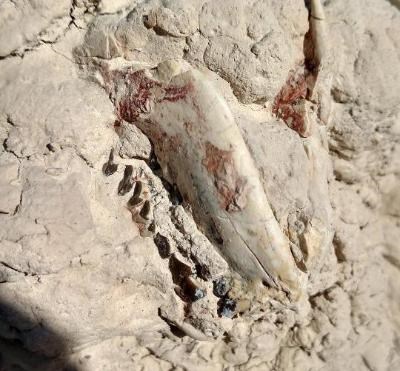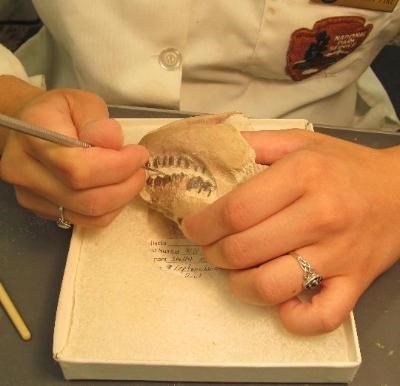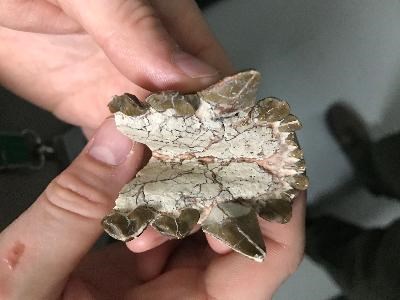Part of a series of articles titled Badlands Geology and Paleontology.
Article
Oreodont: Ancient Grazer of the Badlands

NPS Photo / Ed Welsh

NPS Photo / Ed Welsh
What's an oreodont?
Oreodonts are fossil mammals and are one of the most common fossils found in the Badlands. Oreodonts lived from the Middle Eocene through the end of the Miocene (from about 40 million to 5 million years ago). They were a type of animal called an artiodactyl, which is an even-toed hoofed mammal. Modern artiodactyls include animals like bison and bighorn sheep, both of which can be found in the Badlands today. With four toes, oreodonts also fit the description! In life, oreodonts likely looked like a mix between a camel, sheep, and pig. Their closest living relative is the camel, but they are very distantly related.
Oreodonts were herbivores, meaning that they ate plants like leaves and shoots. We know this partially because of the shape of their teeth – being flat and low, oreodont teeth were meant for chewing and grinding plants. Oreodonts likely lived together in herds as a protective measure against predators like nimravid. Some oreodonts, like Leptauchenia had large auditory bulla (casing for inner ear bones) which indicate that it may have had large ears and exceptional hearing.

NPS Photo / Larry McAfee
What's in a name? What's in a tooth?
While, yes, the name oreodont may inspire thoughts of tasty cookies dunked in milk, these creatures weren’t named for sweets. The first half of the word, “oreo-,” refers to the Greek word for mountain. The second half of the word, “-dont,” is meant to refer to teeth. Think of words like dentist or orthodontist and you may realize that this connection is a familiar one! In sum, oreodonts are named “mountain tooth” for the way that their teeth, and particularly their molars, look like miniature mountain ranges.
Apart from giving animals like oreodonts their unique names, teeth are important to the study of paleontology. Fossil teeth are a diagnostic feature, meaning that the teeth of an animal can often tell paleontologists what type of animal they are looking at. There are some easy basics: for example, long and sharp teeth meant for slicing often indicate a carnivore (a meat-eating animal) where flat and blunt meant for chewing and grinding often indicate an herbivore (a plant-eating animal). But paleontologists use teeth for much more – by measuring teeth and looking for unique traits like cusps, ridges, and serrations, paleontologists can often identify specific animals, right down to the species.

NPS Photo
Oreodonts in the National Parks
Oreodonts are important to the Badlands because they are found in abundance here. They are found most commonly in the Brule Formation, which represents a savannah-like environment with open fields available for grazing and occasional river channels to provide hydration. Given the grazing opportunities in this environment, oreodonts were common. Paleontologists estimate that oreodonts were about as abundant as zebras are on the modern African Serengeti.
Oreodonts are widely diverse. Many types of oreodonts are found in the Badlands, and among them are Miniochoerus, Leptauchenia, and Merycoidodon. Of the oreodonts, Merycoidodon is the one most commonly found in Badlands National Park.
Oreodonts are odd animals overall, but arguably the most strange, and often overlooked, oreodont is Agriochoerus. What sets Agriochoerus apart from other oreodonts, and similar related hoofed mammals, is the hooves have been modified into claws. Clawed hoofed mammals only occur twice in the fossil record. The Agriochoerus lineage represents the only clawed artiodactyls, with their last occurrences in sites like Badlands National Park. If you ever have the chance to visit Agate Fossil Beds National Monument, you could meet the chalicothere Moropus, which is the only other clawed herbivore known, more closely related to horses, rhinos, and tapirs.
But oreodonts are not specific to the Badlands – they can be found in other National Park Service units like Agate Fossil Beds National Monument in Nebraska and John Day Fossil Beds in Oregon.
Last updated: November 10, 2020
